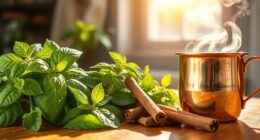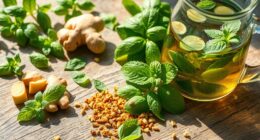As we begin our WoW Classic herbalism journey, we're dedicated to maximizing our skill level, a feat only 22% of players achieve. We'll start by gathering Peacebloom, Silverleaf, and Earthroot in starter zones, then progress to Journeyman level by collecting Bruiseweed, Wild Steelbloom, and Kingsblood. Next, we'll access Expert Herbalism, master advanced herbs, and achieve Artisan Herbalism. We'll explore higher-level zones, master exotic herbs, and reach the maximum skill level. Finally, we'll optimize our routes, identify herbalism hotspots, and continue to refine our skills. As we follow this 10-step guide, we'll uncover the secrets to achieving mastery in WoW Classic herbalism.
Key Takeaways
• Start by gathering Peacebloom, Silverleaf, and Earthroot in starter zones to begin your Herbalism journey.
• Visit an Herbalism trainer to unlock Journeyman Herbalism and access higher-level herbs.
• Reach Expert Herbalism at skill level 125 to unlock access to higher-level herbs in zones like Hillsbrad Foothills and Wetlands.
• Focus on gathering advanced herbs like Dreamfoil, Mountain Silversage, and Plaguebloom to push your Herbalism skill level above 200.
• Explore higher-level zones like Felwood, Hinterlands, and Arathi Highlands to maximize your Herbalism gains and reach the maximum skill level.
Gathering Starter Herbs
We begin our herbalism journey by gathering the most abundant starter herbs in the game, setting ourselves up for a smooth ride through the early skill levels. In WoW Classic, we focus on collecting Peacebloom, Silverleaf, and Earthroot, which are plentiful in starter zones like Durotar, Mulgore, Tirisfal Glades, Elwynn Forest, and Dun Morogh.
These herbs can be found in abundance from skill level 1 to 70, providing a solid foundation for leveling Herbalism. To make the gathering process more efficient, we utilize the Find Herbs skill, which locates these starter herbs on our minimap. By doing so, we can quickly progress through the early skill levels of Herbalism.
Peacebloom is typically found in open areas, while Silverleaf grows near trees and Earthroot can be found near cliffs or rocky terrain. By focusing on these starter herbs first, we set ourselves up for success in the world of WoW Classic Herbalism.
Reaching Journeyman Level

How do we take our herbalism skills to the next level now that we've established a solid foundation in the starter zones?
To access Journeyman Herbalism, we need to visit an Herbalism trainer in any major city like Stormwind, Orgrimmar, Ironforge, or Thunder Bluff. This will grant us entry to higher-level herbs and more advanced gathering techniques.
At this stage, we can gather herbs like Bruiseweed, Wild Steelbloom, and Kingsblood in zones suitable for skill level 115-170. We can also collect Mageroyal, Briarthorn, and Stranglekelp in zones appropriate for skill level 70-115.
Successfully leveling up to Journeyman Herbalism opens the door to more challenging and rewarding herbalism content. We're now one step closer to mastering the art of herbalism.
Our next goal will be to learn Expert Herbalism from a trainer, but for now, let's enjoy the benefits of being a Journeyman Herbalist.
Expert Herbalism Unlocked

Reaching Expert Herbalism at skill level 125 allows us to access a new tier of high-level herbs and challenging zones. By visiting a Herbalism trainer in major cities, we can activate Expert Herbalism, granting entry to higher-level herbs like Bruiseweed, Wild Steelbloom, and Kingsblood.
This skill level range, 115-170, is essential for advancing in Herbalism and accessing more valuable herbs. With Expert Herbalism, we can progress to more challenging zones and gather herbs required for Alchemy recipes. Leveling up to Expert Herbalism opens up new areas like Hillsbrad Foothills and Wetlands for herb gathering, providing us with more opportunities to collect valuable resources.
As we continue to Level up, we'll have more opportunities to explore new zones and gather rare herbs. Expert Herbalism is a significant milestone in our Herbalism journey, and we're excited to explore the new possibilities it offers.
Mastering Advanced Herbs

With our Expert Herbalism skills refined, we're now poised to tackle the coveted advanced herbs in WoW Classic. These advanced herbs, including Dreamfoil, Mountain Silversage, Plaguebloom, Gromsblood, and Golden Sansam, are typically found in higher level zones like Felwood, Blasted Lands, and The Plaguelands.
To efficiently gather these herbs, we'll need to push our Herbalism skill level above 200. Mastering these advanced herbs is essential for crafting high-level Alchemy potions and elixirs, which are in high demand. By doing so, we'll significantly enhance our Herbalism skill and overall gold-making potential in WoW Classic.
As we explore these higher level zones, we'll encounter more challenging terrain and formidable enemies, but the rewards will be well worth the risk. With our skills honed and our knowledge of advanced herbs, we'll be well on our way to becoming master herbalists, capable of crafting the most potent potions and reaping the financial rewards that come with it.
Artisan Herbalism Achieved

We've finally reached the pinnacle of Herbalism mastery, accessing Artisan Herbalism, which opens the door to a new world of high-level herb gathering opportunities. This achievement is a proof of our dedication and perseverance, as we've reached skill level 200 and visited the appropriate trainer. For Alliance, that's in Darnassus, while Horde players head to Thunder Bluff.
With Artisan Herbalism, we can now gather higher-level herbs like Sungrass, Goldthorn, and Fadeleaf, which are essential for high-level Alchemy recipes. This new level of expertise also grants us access to gather herbs in zones like Stranglethorn Vale, Desolace, and Thousand Needles. We're no longer limited to lower-level herbs, and our gathering routes have expanded significantly.
As we venture into these new areas, we'll discover the true potential of our Herbalism skills, and the rewards will be well worth the effort. With Artisan Herbalism, we're ready to take on the challenges of high-level gathering and crafting in WoW Classic.
Farming Elite Herbs

As we shift our focus to farming elite herbs, we need to understand where to find them, how rare they are, and when they'll respawn.
We'll explore the specific locations where elite herbs like Black Lotus, Icecap, and Dreamfoil can be found, as well as their rarity and spawn times.
Elite Herb Locations
We're on the hunt for the most elusive and coveted herbs in WoW Classic, and knowing where to find them is essential to our success. Elite herbs like Black Lotus, Dreamfoil, and Mountain Silversage are highly sought after for their rarity and usefulness in high-level recipes. To get our hands on these lucrative herbs, we need to venture into challenging zones where they spawn.
| Elite Herb | Spawn Locations |
|---|---|
| Black Lotus | Silithus, Eastern Plaguelands, Winterspring |
| Dreamfoil | Azshara, Felwood, Un'Goro Crater |
| Mountain Silversage | Winterspring, Azshara |
Farming these elite herbs can be lucrative, but it's a competitive market. We need to be cautious and aware of our surroundings while farming, as these zones can be dangerous. The payoff is worth it, though, as these herbs are in high demand for crafting powerful potions and elixirs in WoW Classic. By knowing where to find these herbs, we can stay ahead of the competition and reap the rewards of our hard work.
Rarity and Spawn Times
When farming elite herbs, we typically have to contend with lengthy respawn times, an essential factor to take into account when planning our routes and schedules.
Elite herbs like Black Lotus, Dreamfoil, and Mountain Silversage are highly sought after for their use in high-level Alchemy recipes, which contributes to their scarcity and high demand. Due to their rarity, these herbs have longer respawn times, with Black Lotus taking approximately 45-60 minutes to respawn.
This scarcity forces us to be strategic in our farming routes and schedules, ensuring we're in the right place at the right time to snag these valuable herbs. We can't just show up and expect to find them; we need to plan ahead and be prepared to wait.
Optimal Farming Routes
By mapping out efficient routes in zones like Felwood and Winterspring, we can maximize our chances of finding elite herbs like Dreamfoil and Mountain Silversage.
To optimize our farming routes, we utilize addons like GatherMate2 to track herb node locations and plan our route accordingly.
Elite herbs have a longer respawn time, so we need to take that into account when planning our route. We also make sure to check out online resources like WoWhead for detailed maps and guides on farming elite herbs in different zones.
Additionally, we consider grouping up with other players to cover more ground and increase our chances of finding elite herbs while farming.
By working together and using the right tools, we can streamline our Herbalism farming process and level up our skills in WoW Classic.
With efficient farming routes, we can collect the rare herbs we need to craft powerful potions and elixirs, giving us an edge in the game.
Exploring Higher-Level Zones

As we venture into the higher-level zones, we find a treasure trove of herbs waiting to be discovered, with Felwood and Hinterlands standing out as hotspots for leveling up our Herbalism skills.
These zones offer a variety of high-level herbs essential for reaching the maximum Herbalism skill level in WoW Classic. Here are some key highlights:
- Felwood: Rich in Plaguebloom and Dreamfoil, ideal for leveling Herbalism from 270 to 300.
- Hinterlands: Abundant in Sungrass, Purple Lotus, and Ghost Mushroom, necessary for advancing Herbalism skills from 230 to 270.
- Ghost Mushroom Cave: Requires a Herbalism skill of 245 to gather valuable herbs for leveling.
- High-level Herbs: Felwood and Hinterlands provide Gromsblood, Mountain Silversage, and other essential herbs for skill level progression.
Mastering Exotic Herbs

We're now masters of gathering high-level herbs in Felwood and Hinterlands, but mastering exotic herbs like Dreamfoil, Mountain Silversage, and Plaguebloom is important for creating the most potent potions and elixirs in WoW Classic.
These rare herbs are essential for high-level Alchemy recipes, and we need to know where to find them. Felwood is a prime location for gathering Dreamfoil, Mountain Silversage, and Gromsblood, while Ghost Mushrooms can be found in caves, requiring a Herbalism skill of 245 to gather.
As we progress, we'll need to collect Sungrass, Golden Sansam, and Plaguebloom in Felwood, which requires a skill level of 270-300.
Mastering these exotic herbs is crucial for creating the most powerful potions and elixirs in the game. By focusing on these rare herbs, we'll be well on our way to becoming skilled herbalists in WoW Classic.
With our skills honed and our knowledge of these exotic herbs, we'll be able to craft the most sought-after potions and elixirs in the game.
Reaching Maximum Skill

Now that we've mastered the art of gathering exotic herbs, it's time to take our Herbalism skills to the next level by strategically planning our route to maximum proficiency.
To reach the max skill of 300, we need to follow a structured leveling guide, collecting specific herbs in various zones and upgrading our skills with Trainers in major cities.
Here are the key steps to achieve maximum Herbalism skill:
- Zone progression: Progress through different zones, such as Felwood, Stranglethorn Vale, and Arathi Highlands, to collect herbs and level up.
- Trainer upgrades: Visit Trainers in major cities to upgrade our Herbalism skill, allowing us to collect more advanced herbs.
- Herb node farming: Focus on zones with abundant herb nodes to maximize our gathering efficiency.
- Coordinated effort: Plan with party members to optimize our leveling process and minimize downtime.
Maximizing Herbalism Gains

As we focus on maximizing our Herbalism gains, we need to optimize our gathering routes and identify the most lucrative hotspots.
By doing so, we'll be able to collect more herbs in less time, resulting in faster skill gains and increased profits.
Let's explore the best routes and hotspots to take our Herbalism to the next level.
Optimizing Routes
To maximize our herbalism gains, we prioritize planning our gathering routes efficiently, using tools like GatherMate2 or websites like Wowhead to identify high-density herb zones. This strategy allows us to make the most of our time spent gathering herbs.
Here are some key considerations to optimize our routes:
- Prioritize high-density herb zones: Focus on areas like Arathi Highlands or Stranglethorn Vale, which have a high concentration of herb nodes.
- Utilize the Find Herbs ability: This ability helps us locate nearby herb nodes on our minimap, allowing us to adjust our route accordingly.
- Group up with other herbalists: Collaborating with others can help us cover more ground and increase our herb yield per hour.
- Match your skill level to the zone: Focus on zones with high-level herbs that match our skill level to ensure peak efficiency in leveling up our Herbalism.
Herbalism Hotspots
We pinpoint the most lucrative Herbalism hotspots to maximize our gains, focusing on zones that offer an abundance of valuable herbs at each skill level.
As we progress through the ranks, we identify Stranglethorn Vale as a prime hotspot for leveling in the 150-205 skill range, where we can find Liferoot and Goldthorn in abundance.
Earlier on, we find Arathi Highlands to be an excellent spot for leveling from 115 to 170, with Kingsblood and Wild Steelbloom growing in abundance.
As we reach higher levels, we shift our focus to farming Purple Lotus and Firebloom in zones like Tanaris and Searing Gorge to level from 205 to 230.
The Hinterlands then become our go-to hotspot for leveling from 230 to 270, where we can find Sungrass, Purple Lotus, Ghost Mushroom, and Golden Sansam.
Finally, we find Felwood to be a rich zone for leveling from 270 to 300, offering a diverse range of herbs including Dreamfoil, Gromsblood, and Plaguebloom.
Frequently Asked Questions
How to Level up Herbalism in Wow?
When we want to level up herbalism in WoW, we need a clear plan.
First, we start by gathering starter herbs like Peacebloom and Silverleaf in low-level zones.
As we progress, we move on to more challenging zones, collecting higher-level herbs like Mageroyal and Bruiseweed.
With each new skill level, we gain access to new zones and herbs, allowing us to continue leveling up our herbalism skills.
Where to Train Master Herbalism in Wow Classic?
'When in Rome, do as the Romans do' – and in WoW Classic, to excel in herbalism, we need to find the right trainers!
To train Master Herbalism, we head to Loch Modan for Alliance players, where Kali Healtouch awaits, or Hillsbrad Foothills for Horde players, where Aranae Venomblood has got us covered.
With Master Herbalism, we'll access high-level herbs and new nodes in zones like Felwood and The Hinterlands.
Where to Train 300 Herbalism?
We head to Thrallmar for Horde or Honor Hold for Alliance to train our Herbalism to level 300. Ruak Stronghorn and Rorelien, respectively, are the trainers we need to see. They'll teach us advanced techniques, enabling us to efficiently gather high-level herbs in Outland.
Reaching level 300 is vital for maximizing our Herbalism skill in WoW Classic, so we make sure to visit these essential trainers.
How to Level up Herbalism Fast in Dragonflight?
As we venture into the uncharted territories of Dragonflight, we're on a mission to level up our Herbalism skills at lightning speed.
To maximize our gains, we zero in on high-level herbs like Dreamfoil, Mountain Silversage, and Plaguebloom.
We utilize the Find Herbs ability to track down those elusive nodes efficiently.
Conclusion
We've finally reached the pinnacle of herbalism mastery! Our bags are overflowing with rare, exotic herbs, and our skills are unmatched.
We've traversed the vast expanses of Azeroth, braved treacherous landscapes, and conquered the art of herbalism. With our expertise, we can craft potions that grant unimaginable power, and our names are whispered in awe by fellow players.
Our journey was long, but the rewards are immeasurable – we're the Herbalism Masters of WoW Classic!










